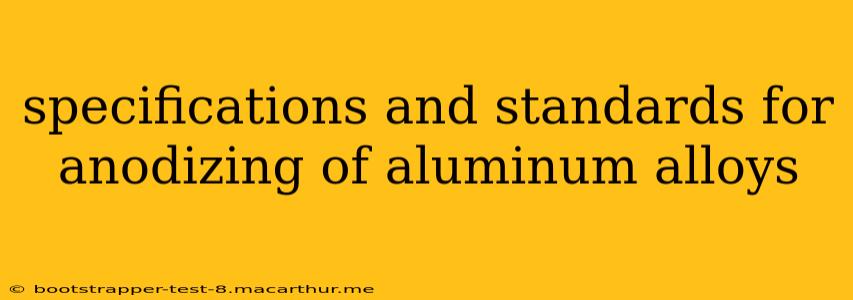Anodizing aluminum alloys is a crucial process for enhancing their durability, corrosion resistance, and aesthetic appeal. Understanding the various specifications and standards governing this process is vital for ensuring consistent, high-quality results. This comprehensive guide delves into the key aspects of anodizing standards, covering different types, applications, and testing methods.
What is Anodizing?
Anodizing is an electrochemical process that converts the aluminum surface into a thicker, more durable layer of aluminum oxide. This protective layer significantly improves the metal's resistance to corrosion, abrasion, and wear. The thickness and properties of this layer are carefully controlled through the anodizing process, which is governed by several industry standards.
Key Standards and Specifications for Anodizing Aluminum
Several organizations worldwide have established standards and specifications for anodizing aluminum alloys. These standards often cover aspects such as:
- Alloy Specifications: The specific aluminum alloy being anodized dictates the anodizing process parameters. Different alloys respond differently to the process, requiring adjustments to achieve optimal results.
- Coating Thickness: The desired thickness of the anodic layer is a crucial factor. Thicker coatings offer superior protection but may affect the final appearance and processing time. Standards specify acceptable thickness ranges for different applications.
- Surface Finish: The pre-anodizing surface finish significantly impacts the final appearance and the quality of the anodized layer. Standards address surface preparation requirements, including cleaning, degreasing, and etching.
- Coloring and Sealing: Anodizing can be further enhanced by applying dyes or pigments to create a variety of colors. Sealing is a crucial post-anodizing step, improving the coating's durability and preventing dye bleed. Standards define acceptable methods and procedures for both coloring and sealing.
- Testing Methods: Various tests are used to assess the quality and performance of the anodized coating, including thickness measurements, corrosion resistance tests, and adhesion tests. Standards specify the testing methods and acceptance criteria.
Major Standards Organizations:
- ASTM International (ASTM): ASTM publishes numerous standards related to anodizing, including those covering specific anodizing processes, testing methods, and coating specifications. Examples include ASTM B580 (Standard Practice for Anodic Oxidation Coatings on Aluminum), and various tests for coating thickness and corrosion resistance.
- MIL-SPEC (Military Specifications): Military specifications are highly stringent standards often used for anodizing components in aerospace and defense applications. These specifications generally require more rigorous quality control and testing procedures.
- ISO (International Organization for Standardization): ISO also publishes relevant standards on anodizing, often aligning with or complementing ASTM standards. These standards provide a global framework for consistent anodizing practices.
Different Types of Anodizing Processes
Several anodizing processes exist, each with specific characteristics and applications:
- Type I (Chromic Acid Anodizing): Known for its excellent corrosion resistance and relatively thin coating. Often used for applications requiring high corrosion resistance.
- Type II (Sulfuric Acid Anodizing): The most common type, offering a thicker coating suitable for a wider range of applications. Often used for architectural applications and decorative finishes.
- Type III (Hard Anodizing): Produces extremely hard and wear-resistant coatings. This process is employed for applications demanding high durability and abrasion resistance.
H2: What are the different types of anodizing finishes available?
Anodizing offers a range of finishes beyond just the basic protective coating. This includes:
- Clear Anodizing: Preserves the natural aluminum color with enhanced durability.
- Colored Anodizing: Achieved by incorporating dyes during the process, offering a wide spectrum of colors.
- Hard Anodizing: Creates a thicker, harder, and more wear-resistant coating. Often used in aerospace and industrial applications.
H2: How is the thickness of the anodized layer measured?
The thickness of the anodized layer is a critical quality parameter. It’s typically measured using techniques like:
- Microscopy: Cross-sectional microscopy provides a direct measurement of the coating thickness.
- Eddy Current Testing: A non-destructive testing method using electromagnetic induction to measure the coating thickness.
H2: What are some common tests for anodized aluminum?
Several tests evaluate the quality and performance of anodized aluminum coatings:
- Salt Spray Test: Assesses the corrosion resistance of the coating by exposing it to a salt spray environment.
- Adhesion Test: Evaluates the bond strength between the anodized layer and the aluminum substrate.
- Thickness Measurement: Essential for confirming that the coating meets the specified thickness requirements.
H2: What are the typical applications of anodized aluminum?
Anodized aluminum's versatility makes it suitable for a wide range of applications, including:
- Aerospace: High corrosion resistance and durability are essential in aerospace components.
- Automotive: Anodizing protects automotive parts from corrosion and wear.
- Architecture: Its aesthetic appeal and durability make it ideal for building facades and architectural elements.
- Electronics: Anodizing provides protection against corrosion and improves heat dissipation in electronic components.
By adhering to the established specifications and standards, manufacturers can ensure consistent quality, performance, and longevity of anodized aluminum components across various industries. The choice of anodizing type and the adherence to testing procedures are crucial for successful application of this vital surface treatment technique.
